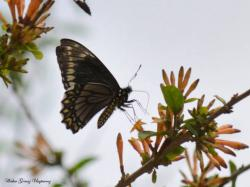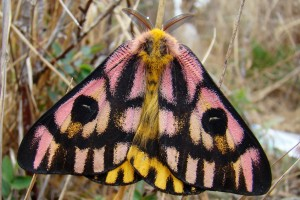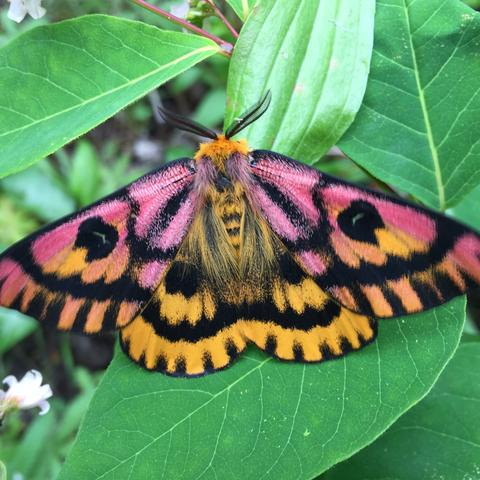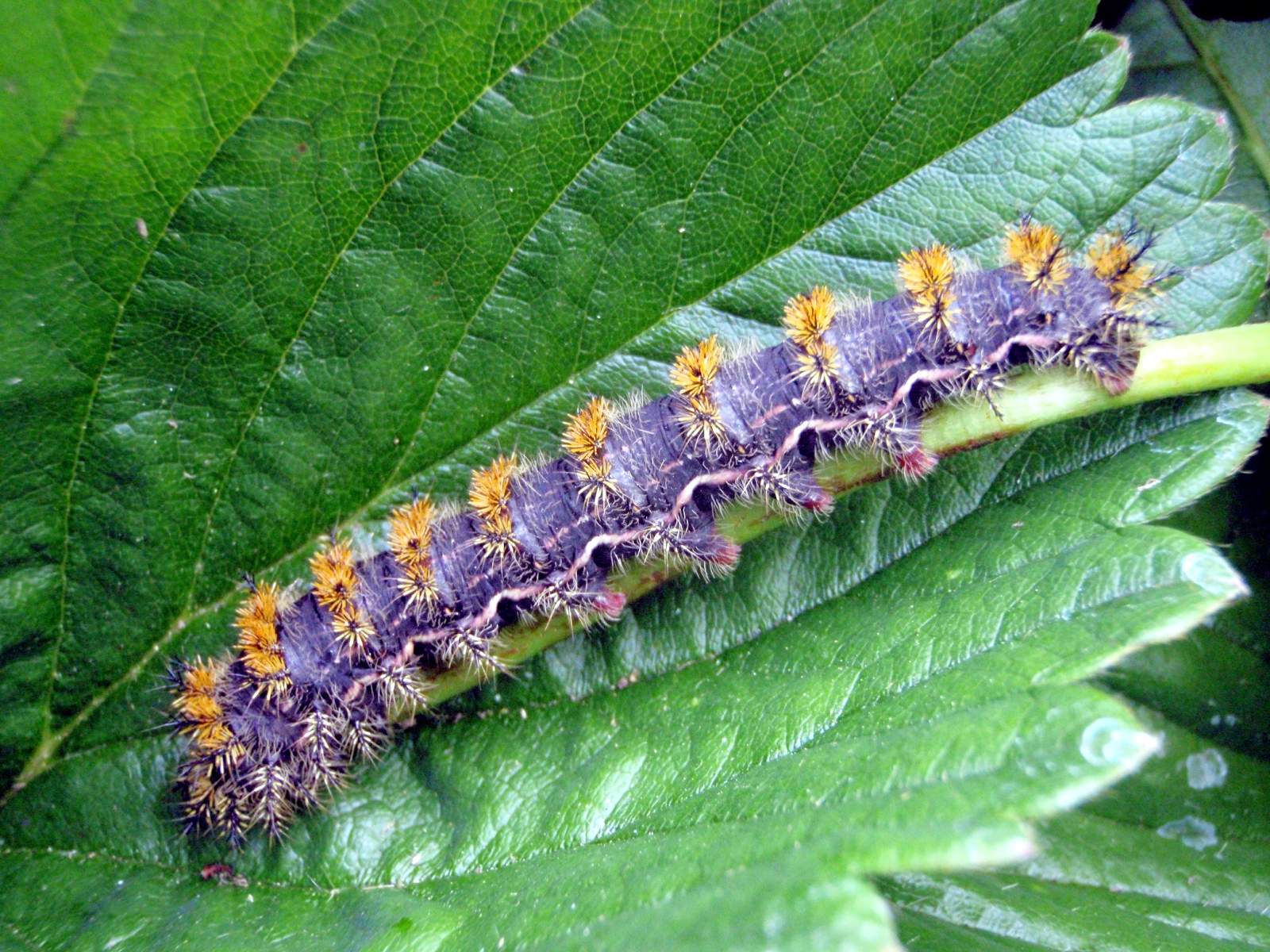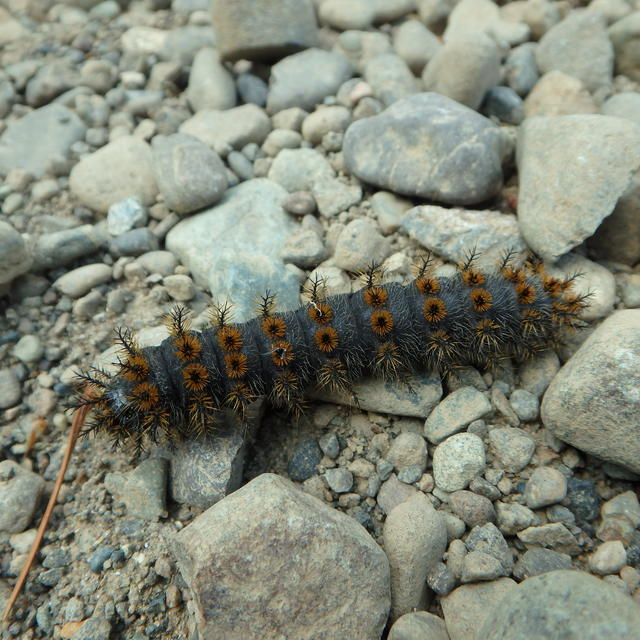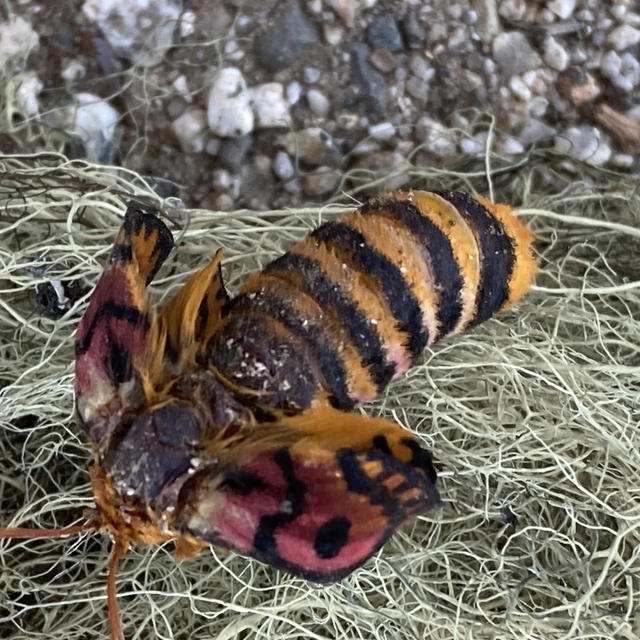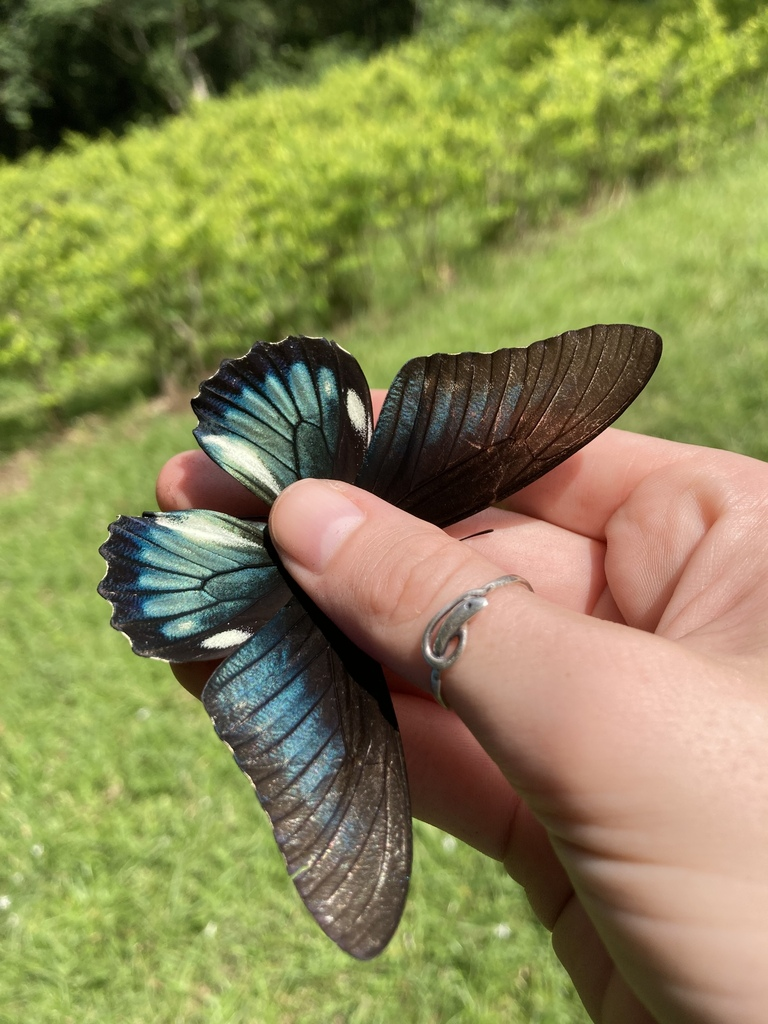Hemileuca eglanterina was presumably so called because it looked like a smaller version of Hemileuca eglanteriae. Eglanteriae has not been counted as a species for a long time. I thought about writing a post about what the moths called that are called now. The Internet didn't cooperate. Likely eglanteriae was determined to be a variant of H. hera, because H. eglanterina are good-sized moths, with a wingspan typically about three inches, and hera have similar markings and are even bigger. Hera are, however, mostly black and white, where as eglanterina...are sometimes black and white, on the forewings, and sometimes colorful.
This photo appears in different places around the internet, including a Tumblr account called Onenicebugperday. The moth might qualify as nice, though it's certainly not a bug, after it's grown its wings. Last summer, as a caterpillar, it was about as nasty as the Lepidopterae can be.
But eglanterina is still recognized as a species, usually called the Common Sheep Moth because it's found in fields where sheep pasture, but sometimes called the Elegant Day Moth. It flies in the daytime; some might think the subtle gray and white or dramatic black and white Hemileucas looked more elegant, but in the 1850s, when this moth was first written about, bright aniline-dyed colors were the newest thing.. It is large, in no danger of extinction, and hard to overlook. It is well documented on the Internet. Instead of asking whether there are any good clear images of living specimens to show you, while writing this post I wondered how many pictures of these moths anyone wanted to look at. These moths inspire artists as well as photographers; since this is a science post I've made an arbitrary decision not to show pictures of moth postcards or moth-shaped stuffed toys.
Most of the big silk moths, for instance, rest with their wings out to the sides. Hemileucas, like most of the smaller moths, usually fold their wings in and make themselves look a little smaller and less conspicuous. But occasionally they hold their wings straight up, like butterflies, showing the undersides of the wings:
Birds usually learn to avoid bright colors when looking for insects to eat, but eglanterina has an additional trick to surprise birds.
Photo donated to Wikipedia by Gillian Bowser.
These moths are found in the Western States and Canada. They are reported from the Rocky Mountains to the coast, but not in Texas. Eglanterina has not been found in Iowa, but Iowa State University has posted a bibliography of books and important articles about it:
The base color is yellowish brown with darker brown markings. Museum specimens fade to drab yellowish brown. Living moths can look downright psychedelic in bright light, with orange, pink, and green highlights of almost Day-Glo intensity, making the dark markings look black by contrast. Bodies are often orange or yellow with black stripes like bees, but can be pink with black dots over the spiracles (breathing pores) on the sides, or pink with black stripes. Thus, while tropical countries have butterflies whose normally red coloring can fade to pink, Hemileuca eglanterina is the closest thing North America has to a pink butterfly. Males tend to show more and darker brown markings than females, though not consistently enough to establish a rule for identifying the sex of an individual. Variations are observed.
Photo from Bart Jones on Flickr.
A variation called denudata, sometimes listed as a separate species, has fewer colored scales on its wings, altogether, than it seems to need, and almost all the scales are yellow or yellowish. A variation called shastaensis, also sometimes counted as a separate species, can be almost all black.
Denudata from Theinsectcollector.com. The brighter yellow patches on the forewings show where
Hemileucas of most, if not all, species and subspecies seem to be prone to having translucent, thinly scaled patches.
Shastaensis, snogging. Only a few moths seem to feel physical affection for each other.
Hemileucas are among the few. Siblings, immune to each other's stinging spines, cling together in a group hug regularly; adults canoodle before, during, and after mating.
There has been much discussion of how many subspecies of eglanterina should be counted and whether things like Hemileuca annulata, discussed earlier in this series, should be considered subspecies of eglanterina. The confusion about which of the Hemileucas are separate species comes from the fact that these moths defy our ideas of what makes a species.
We learn in school that if lifeforms will readily crossbreed or cross-pollinate with each other and produce viable offspring, those lifeforms are different variants within one species; if they can be crossbred or cross-pollinated with human interference, and produce sterile or otherwise biologically disadvantaged offspring, they are different species within one genus; if they can't be crossbred simply by pollination or insemination, they belong to different genera. The Hemileucas all have a sort of family resemblance to one another, and their different looks seem to be produced by eating different food. Individuals classified as belonging to different species and subspecies may be mutually attracted, choose each other as mates, and produce offspring--but the eggs may not hatch, or the caterpillars may not be able to survive. Eglanterina eat different plants and have different looks--and the variations produced by their eating different plants can be enough to prevent a pair of moths producing viable offspring. The latest big authoritative book on the subject reaches the conclusion that at most six of the fifty apparent speies of Hemileuca are truly distinct species, rather than variations produced by environmental factors at least as much as hereditary factors.
We've looked at some scientific studies of other Hemileucas' ability to crossbreed; here's one that features eglanterina:
Photo anonymously donated to Butterfliesadmoths.org by someone who noted that it was taken in British Columbia.
Like all the
Hemileucas it's a right old nuisance. The caterpillars can eat different plants but are often found on fruit trees and rosebushes. Like all the big silk moth caterpillars they are clumsy and can fall out of trees, often curling into a ball with all their venomous branching bristles turned out. The venom produces relatively mild skin irritation relative to some other creatures in this region, more lasting than cactus spines, less serious than rattlesnake bites.
Though inactive for most of each year, some of these moths seem typically to have a two-year life cycle. Eggs laid in summer hatch next spring. Caterpillars crawl all through the next summer, pupate the next winter, and finally emerge as moths almost two years after their appearance as eggs.
People have posted not only photos but videos of moths laying eggs:
Like other Hemileucas, the young caterpillars live in clusters. They don't spin webs to form nests but do cuddle together to regulate body heat during the chill of the night and the heat of the day. This extreme gregariousness lasts through their first three skins. After the third molt they separate and explore the world.
The close-knit family, photographed by Weflybye in Washington state.
Caterpillars are basically black with increasing amounts of white speckles, forming lengthwise stripes in shades of black, white, and gray, as they grow bigger. In some individuals some or all of the lighter specks, and the bristles, may show color. The most typical and recognizable caterpillars have yellow bristles at least on the back, but some have blackish gray bristles. Some have pink strips on the skin. These bright colors can be present in baby caterpillars, still living in a clump.
Photo by Scott Burgess in California.
This one looks positively purple in my browser. Since nobody else describes the caterpillars as purple, violet, or periwinkle I'm guessing that that's a browser issue. Everyone does agree about the striped patterns on the skin and the tendency for only the bristles on the upper back to be yellow (sometimes even orange) while other bristles are still gray.
Photo from GCSnelling, taken in San Bernardino county, California.
This photo from Lanalee in Canada shows the pink striping sometimes reported in the caterpillars' skins.
In a thorough, informative photo essay, Caitlin LaBar reports that a brood of eglanterina she reared moved readily among different food plants. Possibly that movement produced the variations she saw in her caterpillars. Even in the early stages, some started to show black bristles and some to show yellow bristles. Some had greenish yellow bristles and blackish gray skins; some had blackish gray bristles and skins; and, before pupating, the final caterpillar skins turned orange. As the animals went into pupation, black bristly skins fell away from yellow-orange pupae.
The pupal skin has no bristles. There may or may not be some attempt in the direction of a cocoon; for silk moths the Hemileucas produce very little silk. Pupation is a vulnerable time for these moths. They burrow a little way into the sand and hope nothing finds them for months when they're not able to move much. Then one warm day a furry, intense-looking moth with stubby wings crawls up from the ground onto a plant stalk and starts the process, which lasts a few hours, of expanding its wings. During these hours the moth is also releasing a scent that humans don't notice, but other moths do. Males recognize the scent of a female and gather around to wait for her to decide she's an adult and mate. Usually she chooses a mate as soon as her wings reach their full size.
Not very pretty without her wings, she looks fat because she's full of egg material. Hemileucas live on fat they've stored up while they were very hungry caterpillars, but they don't store much or live long. Photo by Sidnetaske in Oregon.
Tanya snapped a whole photo essay showing the dowdy-looking moth slowly spreading its wings:
Exactly what this crawling egg sac--that's not really fair, she looks like an adult moth by the time the males find her--does to attract males has been scientifically studied, too. While moth blood, or haemolymph, is pumping into her wing veins and expanding her wings, it's still pumping through the rest of her, perfuming the air at every microscopic heartbeat with her species-specific scent. Humans don't smell it, but that has not stopped chemists trying to collect and analyze it.
Variations among local populations have been compared...you realize the chemists have to consult male moths to have any idea what they're studying. But they are motivated. If humans knew what attracts the male moths we might be able to attract all of them to traps and prevent these wretched moths reproducing in the vicinity of farms, towns, or nature parks.
When possible, the Hemileucas mate face to face. To do this they use most of their legs to hold on to a twig, but they usually spend some time snuggling--unlike most of the more lovable (to humans) moths and butterflies, whose focus seems to be on protecting their wings from touching while they get the eggs fertilized as fast as possible.
Those two's variations are gender-typical, but there are no solid rules with Hemileucas except that males don't have that egg-stuffed body shape. (When crawling up away from their pupae they look about as grotesque as the females, only thinner.) Females eclose from the pupal shell fully loaded with egg material, but then they get rid of it as quickly as possible. Male moths usually have more luxuriantly plumy antennae than females; as shown, with Hemileucas that's not guaranteed either. Both sexes' long abdominal sections are flexible enough that they can mate while standing side by side if they can't find a suitable twig right away.
Basically, when we observe these animals without a microscope, the ones that act like males are the males, and the ones that act like females are the females. (Or, more helpfully: males fly around looking for females, who usually attract crowds of males while waiting for their wings to expand after emerging from their pupae, and then females fly around laying eggs.) They may fly at any time in June, July, or August, but are most often found in July.
Someone posted a photo of an over-eager female mating back to back before her wings were half their eventual size. Oh, what moral lessons might be drawn. Being impatient cost her the chance to cuddle and may have caused or correlated with something wrong with the timing and viability of her eggs. But I thought that picture might be too explicit for this site's contract (moth porn!) and would probably be too ugly for most readers, because the impatient girl moth was unable to cover her tail end..
Incredible to me, or confirming the stereotypes some people have about Californians, there are people who want these moths to reproduce successfully. My own feeling is that the picture of the mating pair is useful to show people what to whack with something solid, at once, to spare others from having to deal with a few dozen more stingingworms next year. (A pair will normally produce up to a hundred eggs; most eggs don't become moths.) Nevertheless there are people who, in places where they see Monarchs and Viceroys, Vanessas, Tiger Swallowtails, Giant Swallowtails, California Tortoiseshells, Lunas, Antiopas, Melissas, Sphinxes, Polyphemuses, Fritillaries, Zebra Longwings, Skippers, and California's own peculiar kinds of giant silk moths, claim this nuisance species as a favorite:
California can't be blamed for this one. I think confusion can. Person says person has seen only a few dying caterpillars. Still...the first time I ever saw a stingingworm, age fifteen, I could see that it was something that needed killing. I'd heard so many harmless caterpillars misidentified as stingingworms and I just intuitively knew the real thing when I saw it. How is it possible not to see...?
One reason may be that the family Hemileucinae includes some harmless mimics--caterpillars who may be as big as the Hemileucas or bigger, live in the same territory, even get their colors from the same food plants, and have branching bristles whose blunt tips don't contain venom. This one has crosswise rather than lengthwise stripes, the bristles are yellow all the way around, and both the body and bristles are skinnier than on the stingingworms above. I don't know, but I think it's possible that this one is tickling the human hand harmlessly because it's a harmless mimic. If not, somebody's likely to be sorry this picture was taken.
All stingingworms are overprotected and seldom preyed on by birds or mice. They are vulnerable to predators that are smaller than they are, able to slip in between their barbs. Stingingworms are often parasitized by tiny wasps.
The caterpillars often survive being parasitized until the wasp larvae dig their way out through the caterpillar's skin and pupate in tiny egglike cocoons stuck to its body. However, they won't become moths.
The brachonid wasps attack tomato hornworms, too. They're sometimes sold to farmers who want to get rid of these two nuisance species. Both brachonid pictures from Bugguide.
In 2003 Paul Severns reported on exactly how stingingworms adapt to survive even California wildfires. Fires usually destroy eggs, but enough female moths typically survive, and female moths are strongly enough attracted to scorched twigs, that populations rebound next year. The mother moths seem instinctively to sense that a place that has had one big fire isn't likely to have another big fire that year, so the eggs will be safe, and next year the native plants will grow faster in soil freshly fertilized by mineral-rich ashes. They probably have no way to observe this and report it to one another; most likely scorched wood just smells good to them.
From her own kind's point of view, anyway, a symbol of hope.


